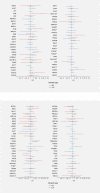Familial breast cancer and DNA repair genes: Insights into known and novel susceptibility genes from the GENESIS study, and implications for multigene panel testing
- PMID: 30303537
- PMCID: PMC6587727
- DOI: 10.1002/ijc.31921
Familial breast cancer and DNA repair genes: Insights into known and novel susceptibility genes from the GENESIS study, and implications for multigene panel testing
Abstract
Pathogenic variants in BRCA1 and BRCA2 only explain the underlying genetic cause of about 10% of hereditary breast and ovarian cancer families. Because of cost-effectiveness, multigene panel testing is often performed even if the clinical utility of testing most of the genes remains questionable. The purpose of our study was to assess the contribution of rare, deleterious-predicted variants in DNA repair genes in familial breast cancer (BC) in a well-characterized and homogeneous population. We analyzed 113 DNA repair genes selected from either an exome sequencing or a candidate gene approach in the GENESIS study, which includes familial BC cases with no BRCA1 or BRCA2 mutation and having a sister with BC (N = 1,207), and general population controls (N = 1,199). Sequencing data were filtered for rare loss-of-function variants (LoF) and likely deleterious missense variants (MV). We confirmed associations between LoF and MV in PALB2, ATM and CHEK2 and BC occurrence. We also identified for the first time associations between FANCI, MAST1, POLH and RTEL1 and BC susceptibility. Unlike other associated genes, carriers of an ATM LoF had a significantly higher risk of developing BC than carriers of an ATM MV (ORLoF = 17.4 vs. ORMV = 1.6; p Het = 0.002). Hence, our approach allowed us to specify BC relative risks associated with deleterious-predicted variants in PALB2, ATM and CHEK2 and to add MAST1, POLH, RTEL1 and FANCI to the list of DNA repair genes possibly involved in BC susceptibility. We also highlight that different types of variants within the same gene can lead to different risk estimates.
Keywords: breast cancer; case-control study; exome sequencing; multigene panel testing; variant.
© 2018 The Authors. International Journal of Cancer published by John Wiley & Sons Ltd on behalf of UICC.
Figures


References
-
- Collaborative Group on Hormonal Factors in Breast C . Breast cancer and hormonal contraceptives: collaborative reanalysis of individual data on 53 297 women with breast cancer and 100 239 women without breast cancer from 54 epidemiological studies. Lancet 1996;347:1713–27. - PubMed
-
- Thompson ER, Rowley SM, Li N, et al. Panel testing for familial breast cancer: calibrating the tension between research and clinical care. J Clin Oncol 2016;34:1455–9. - PubMed
Publication types
MeSH terms
Supplementary concepts
LinkOut - more resources
Full Text Sources
Medical
Research Materials
Miscellaneous

